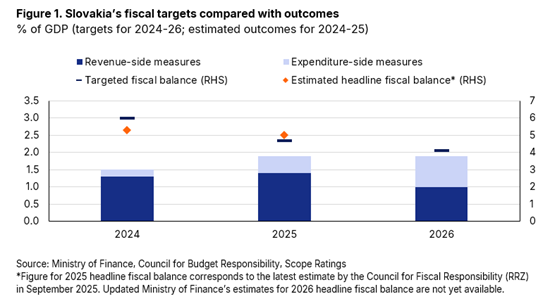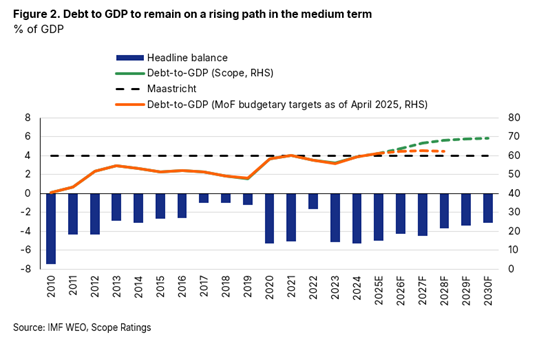Announcements
Drinks
Slovakia: increasing consolidation fatigue challenges medium-term fiscal sustainability
By Alessandra Poli, Sovereign & Public Sector
The government recently approved a third fiscal consolidation package to be implemented in 2026 worth EUR 2.7bn (2% of GDP).
While the plan is ambitious, the task of bringing long-lasting benefits to Slovakia’s (A/Negative) public finances is complicated by the export-oriented economy’s vulnerability to higher US tariffs and the slowdown among main European trade partners.
We expect a material slowdown in GDP growth this year and next year. We have revised down real GDP growth forecasts for 2025 to 0.8%, from 1.5% previously estimated, and to 1.2% in 2026, from 1.7%. Slovakia’s projected economic growth this year will remain well below some peers in the CEE region, such as Poland (A/Stable, +3.1%), Slovenia (A+/Stable, +1.8%) and Czech Republic (AA-/Stable, +2.3%).
As the fiscal consolidation package comprises a substantial number of revenue-raising measures, it is likely to prove a drag on growth, weighing down on domestic private consumption, business activity and reducing the scale of potential benefits for growth in public revenue. Some measures are temporary, so additional fiscal consolidation will be necessary in the coming years to safeguard fiscal sustainability.
The new fiscal consolidation package – approved by the government at end-September and awaiting presidential signature at the time of writing – could help the government to bring the deficit down to the 4.1% of GDP target next year from an estimated 5% of GDP in 2025. This follows two previous packages implemented in 2024 (EUR 1.9bn, 1.5% of GDP) and in 2025 (EUR 2.7bn, 1.9% of GDP) attempted to reverse the negative impact of previous fiscal loosening. Most of the measures planned for 2026 (EUR 1.4bn) aim to boost revenues mainly through making personal income tax more progressive and increasing health and social contributions, among others (Figure 1).

Further consolidation efforts will be necessary to safeguard fiscal sustainability
In contrast, the government is yet to give the details of EUR 1.3bn in planned expenditure cutbacks. A portion of these savings could include refunds of previous large-scale energy subsidies, amounting to EUR 435m, neutralising their previous adverse impact on the deficit.
The remaining expenditure savings will likely include cuts to the public administration operating and personnel costs, savings in local government spending. The government is likely to steer clear of major revision to pension and social transfers to avoid harming living standards for the most vulnerable households.
The scale of revenue-side consolidation measures will likely hamper an already slowing economy, with higher US tariffs holding back demand for Slovakia’s good exports, which could feed through to lower tax receipts and higher welfare spending.
In addition, the temporary nature of some measures – a one-off cancellation of two public holidays, a temporary freeze on wages and temporary suspension in the adjustment of the extra annual pension payment for inflation – could limit the durability of the fiscal adjustment. This would require additional austerity in the coming years to prevent wider budget deficits and a steeper debt-to-GDP trajectory.
In this context, the risk of a fiscal consolidation trap amid growing consolidation fatigue is growing. We currently project the public debt-to-GDP ratio for Slovakia to continue to increase gradually up to around 69% by 2030, from 59.3% in 2024 (Figure 2).

NATO commitments, run-up to 2027 election could complicate debt reduction
A slowdown in the economic activity would also result in lower contribution from growth to the reduction of government debt.
Further strain on government spending could stem from pressures to increase military spending, for which the new NATO target has now set at 3.5% of GDP by 2035, above Slovakia’s estimated 2% of GDP as of 2024. Moreover, potential attempts for additional fiscal consolidation could be particularly challenging going forward, especially in 2027, being an election year.
Scope’s next calendar review date for Slovakia is 5 December 2025.







